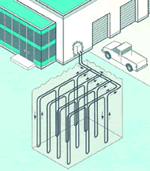Geoexchange Systems Provide Energy-Efficient Heating and Cooling

More Articles
- Green Computers Save Energy and Cut Waste
- Green Homes: A Bright Spot in the Housing Market
- Rebates - Free Money for Your Efficiency Projects
- Is Your Home Leaking Money?
- Don't Let Your Fireplace Burn a Hole in Your Wallet
- Families Compete to Save Energy in "Energy Smackdown"
- Making Solar Easy - New Options for Homeowners
- Recycle - Save Energy, Resources and the Environment
- Standby Power - The Silent Energy Drain
- The Fast and Easy Way to Cut Your CO2 Emissions
- The Fight Against Global Warming Comes Home
- Big Screens Mean Big Energy Bills
- Save Energy at the Tap
With the building industry increasingly focused on energy efficiency, geoexchange systems are emerging as an excellent option for boosting the efficiency of heating and cooling systems. Geoexchange machines, also known as ground-source or geothermal heat pumps, are efficient alternatives to fossil fuel-fired boilers, reports Eco-Structure magazine.
Traditional heat pump systems work by transferring heat rather than creating it and rely on the vapor compression of a refrigerant to heat or cool, depending on the direction of refrigerant flow. Most of these systems rely on the outside air or an in-building water loop to act as a heat sink and exchanger. For example: When cooling is required, the system captures heat from the indoor air and transfers it to the outdoor air through a condensing unit.
Geoexchange machines use the earth as a giant heat absorber and supplier by sinking the exchange system in the ground, where temperature fluctuates much less. The earth absorbs heat from outside air when cooling is required and supplies heat to outside air when heating is required. These systems eliminate the need for a chiller/cooling tower and a fossil fuel-fired boiler altogether, greatly reducing the greenhouse gas emissions of the building.
A 1993 U.S. Environmental Protection Agency report showed that geoexchange systems are the most energy-efficient and environmentally friendly heating and cooling machines available for buildings, and have the lowest life-cycle costs compared to other systems. While currently only 1% of the HVAC market, geoexchange use is growing rapidly because of the efficiency and environmental benefits it offers.
Related: New Heat-Pump Retrofit Gives Homeowners Option to Save Energy With Existing Water Heaters (e-Newswire, 7/23/08)










